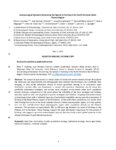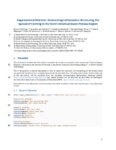1 - 25 of 13
| Creator | Title | Description | Subject | Date | ||
|---|---|---|---|---|---|---|
| 1 |
 |
Codding, Brian F. | Socioecological dynamics structuring the spread of farming in the North American Basin-Plateau Region | The spread of agriculture is a major driver of social and environmental change throughout 25 the Holocene, yet experimental and ethnographic data indicate that farming is less profitable than foraging, so why would individuals choose to adopt agriculture leading to its expansion? Ideal distribution ... | Ideal free distribution model; population ecology; behavioral ecology; maize agriculture; Ancestral Puebloan; Fremont Complex | 2021 |
| 2 |
 |
Codding, Brian F. | A land of work: foraging behavior and ecology | Work is a core theme in many of the major issues and debates in California archaeology. Work is central in understanding why the first Californians entered the region (e.g., Erlandson, this volume): how thousands of years of work following colonization resulted in the overexploitation of particular ... | Human behavioral ecology; Hunter-gatherer; North America: California | 2012-03-15 |
| 3 |
 |
Bell, Adrian | Driving factors in the colonization of Oceania: developing island-level statistical models to test competing hypotheses (Electronic Supporting Material) | To test the model specification and fitting algorithms, we simulated data using randomly generated parameters, settlement chronology, and accessibility matrix for N islands. Using the function optim in R, we found the maximum likelihood estimates and compared them with the "true" parameter values us... | Oceania; Archaeology; Settlement; Statistical models | 2015-01-23 |
| 4 |
 |
Rogers, Alan R.; Jorde, Lynn B. | Genetic structure of the Utah Mormons: comparison of results based on RFLPs, blood groups, migration matrices, isonymy, and pedigrees | The genetic structure of the Utah Mormon population is examined using 25 blood group and 47 RFLP alleles obtained from 442 subjects living in 8 geographic subdivisions. Nei's Gst was 0.013 (p < 0.002) for the RFLP data and 0.012 (p > 0.4) for the blood group data, showing that only 1% of the geneti... | 1994 | |
| 5 |
 |
Codding, Brian F. | External impacts on internal dynamics: Effects of paleoclimatic and demographic variability on acorn exploitation along the Central California coast | Research into human-environment interaction in California prehistory often focuses on either the internal dynamics of adaptive decisions or the external impacts of environmental change. While both processes were surely driving prehistoric variability, integrating these approaches is not altogether s... | Acorn exploitation; Prehistoric land use; Behavioral ecology | 2016 |
| 6 |
 |
Codding, Brian F. | Supplementary Materials: Socioecological dynamics structuring the spread of farming in the North American Basin-Plateau Region | This document includes the code used to complete the analysis presented in the manuscript "Socioecological Dynamics Structuring the Spread of Farming in the North American Basin-Plateau Region" in Environmental 15 Archaeology. | environmental archaeology | |
| 7 |
 |
Codding, Brian F. | Environmental productivity predicts migration, demographic, and linguistic patterns in prehistoric California | Global patterns of ethnolinguistic diversity vary tremendously. Some regions show very little variation even across vast expanses, whereas others exhibit dense mosaics of different languages spoken alongside one another. Compared with the rest of Native North America, prehistoric California exemplif... | Colonization of North America; Prehistoric migrations; Human behavioral ecology; Ideal free distribution; Ideal despotic distribution | 2013-09-03 |
| 8 |
 |
Wiessner, Pauline W. | Wealth transmission and inequality among hunter-gatherers | We report quantitative estimates of intergenerational transmission and population-wide inequality for wealth measures in a set of hunter-gatherer populations. Wealth is defined broadly as factors that contribute to individual or household well-being, ranging from embodied forms, such as weight and h... | 2010-02 | |
| 9 |
 |
Harpending, Henry C.; Jorde, Lynn B. | Culture creates genetic structure in the Caucasus: autosomal, mitochondrial, and Y-chromosomal variation in Daghestan | Near the junction of three major continents, the Caucasus region has been an important thoroughfare for human migration. While the Caucasus Mountains have diverted human traffic to the few lowland regions that provide a gateway from north to south between the Caspian and Black Seas, highland populat... | Caucasus; Haplogroups; Autosomal variation; Mitochondrial variation; Y-chromosomal variation; Endogamy; Avar; Dargin; Kubachi; Culture | 2008 |
| 10 |
 |
Rogers, Alan R.; Jorde, Lynn B. | Founder effect: assessment of variation in genetic contributions among founders | We present a Monte Carlo method for determining the distribution of founders' genetic contributions to descendant cohorts. The simulation of genes through known pedigrees generates the probability distributions of contributed genes in recent cohorts of descendants, their means, and their variances. | 1994 | |
| 11 |
 |
Codding, Brian F. | Explaining prehistoric variation in the abundance of large prey: a zooarchaeological analysis of deer and rabbit hunting along the Pecho Coast of Central California | Three main hypotheses are commonly employed to explain diachronic variation in the relative abun dance of remains of large terrestrial herbivores: (1) large prey populations decline as a function of anthro pogenic overexploitation; (2 ) large prey tends to increase as a result of increasing social p... | Foraging; Resource depression; Prestige hunting; Paleoclimatic variability; Human behavioral ecology; Zooarchaeology; Central California | 2009-11-14 |
| 12 |
 |
O'Rourke, Dennis H. | Hrdlič̌ka's Aleutian population-replacement hypothesis: a radiometric evaluation | In a 1945 monograph, Hrdlička argued that, at 1,000 BP, Paleo-Aleut people on Umnak Island were replaced by Neo-Aleut groups moving west along the island chain. His argument was based on cranial measurements of skeletal remains from Chaluka Midden and mummified remains from Kagamil and Ship Rock b... | Population replacement; Paleo-Aleuts; Neo-Aleuts | 2006 |
| 13 |
 |
Hawkes, Kristen | Hunting and nuclear families: some lessons from the Hadza about men's work | Hadza hunter-gatherers display economic and social features usually assumed to indicate the dependence of wives and children on provisioning husbands and fathers. The wives and children of better Hadza hunters have been found to be better-nourished, consistent with the assumption that men hunt to pr... | Subsistence economy; Tindiga, African people; Subsistence hunting | 2001-10-24 |
1 - 25 of 13
